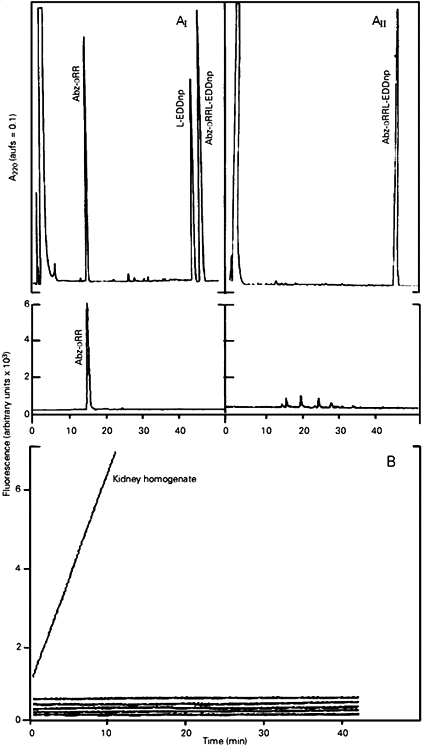Two intramolecularly quenched fluorogenic peptides containing o-aminobenzoyl (Abz) and ethylenediamine 2,4-dinitrophenyl (EDDnp) groups at amino- and carboxyl-terminal amino acid residues, Abz-<!-- $MVD$:face("Times") -->DArg-Arg-Leu-EDDnp (Abz-<!-- $MVD$:face("Times") -->DRRL-EDDnp) and Abz-<!-- $MVD$:face("Times") -->DArg-Arg-Phe-EDDnp (Abz-<!-- $MVD$:face("Times") -->DRRF-EDDnp), were selectively hydrolyzed by neutral endopeptidase (NEP, enkephalinase, neprilysin, EC 3.4.24.11) at the Arg-Leu and Arg-Phe bonds, respectively. The kinetic parameters for the NEP-catalyzed hydrolysis of Abz-<!-- $MVD$:face("Times") -->DRRL-EDDnp and Abz-<!-- $MVD$:face("Times") -->DRRF-EDDnp were Km = 2.8 µM, kcat = 5.3 min-1, kcat/Km = 2 min-1 µM-1 and Km = 5.0 µM, kcat = 7.0 min-1, kcat/Km = 1.4 min-1 µM-1, respectively. The high specificity of these substrates was demonstrated by their resistance to hydrolysis by metalloproteases [thermolysin (EC 3.4.24.2), angiotensin-converting enzyme (ACE; EC 3.4.24.15)], serineproteases [trypsin (EC 3.4.21.4), <!-- $MVD$:face("Symbol") --><FONT FACE="Symbol">a</font>-chymotrypsin (EC 3.4.21.1)] and proteases present in tissue homogenates from kidney, lung, brain and testis. The blocked amino- and carboxyl-terminal amino acids protected these substrates against the action of aminopeptidases, carboxypeptidases and ACE. Furthermore, <!-- $MVD$:face("Times") -->DR amino acids ensured total protection of Abz-<!-- $MVD$:face("Times") -->DRRL-EDDnp and Abz-<!-- $MVD$:face("Times") -->DRRF-EDDnp against the action of thermolysin and trypsin. Leu-EDDnp and Phe-EDDnp were resistant to hydrolysis by <!-- $MVD$:face("Symbol") --><FONT FACE="Symbol">a</font>-chymotrypsin. The high specifity of these substrates suggests their use for specific NEP assays in crude enzyme preparations
neutral endopeptidase; enkephalinase; neprilysin; fluorogenic substrates; phosphoramidon



